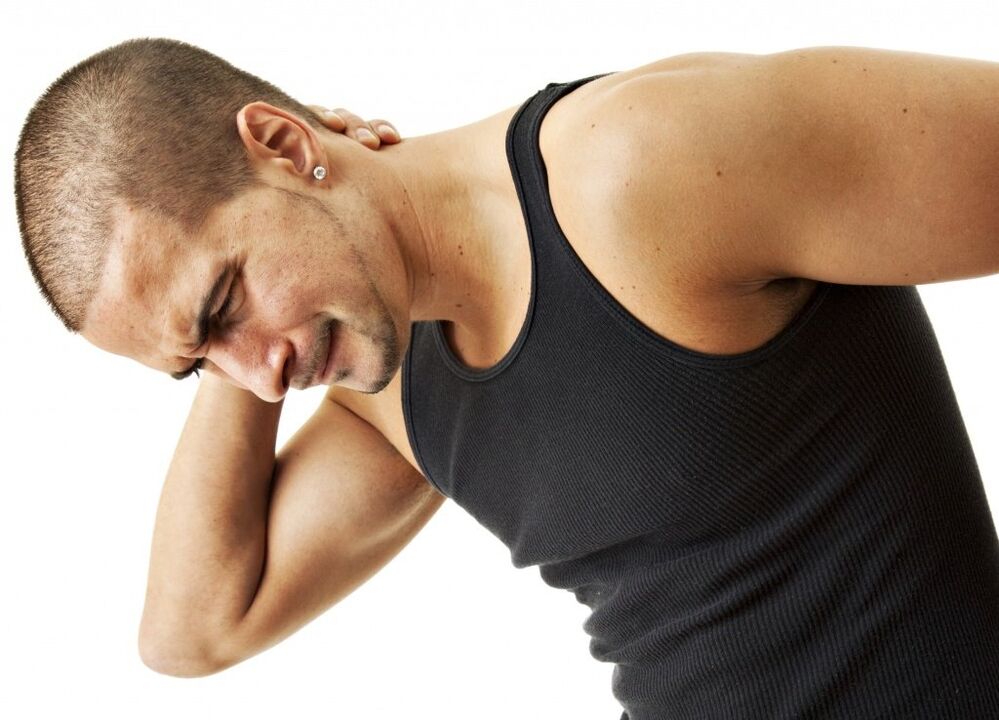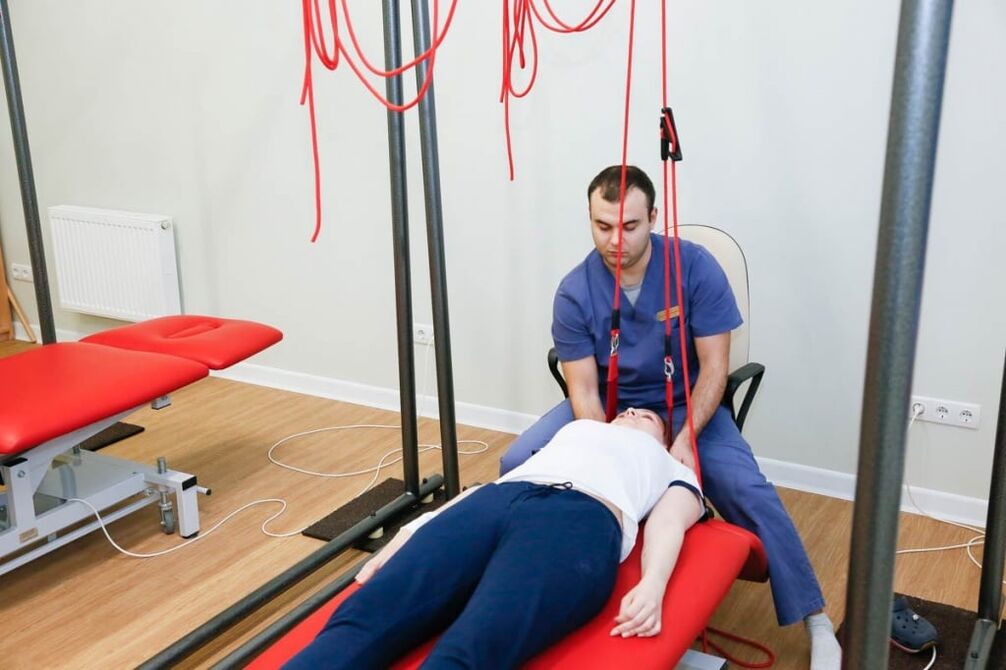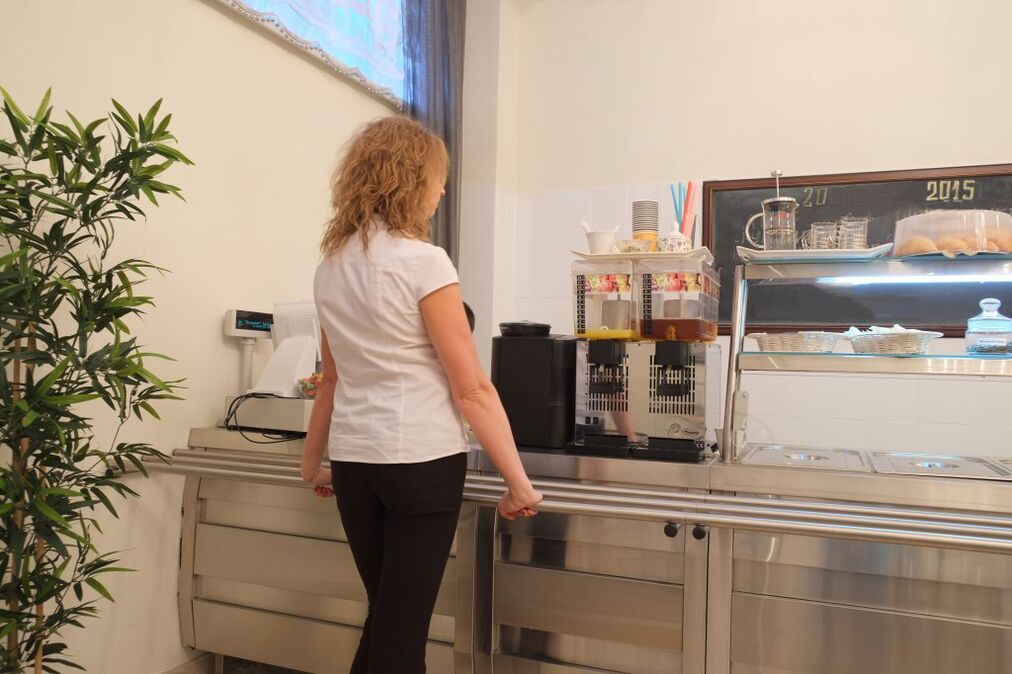Cervical osteochondrosis is a condition that affects the vertebrae and intervertebral discs. Cervical osteochondrosis refers to deforming dorsopathies. Involutionary changes in the intervertebral discs were observed as early as 20 years of age. At the same time, they become more sensitive to stress, less elastic and lose lubricating fluid.
Most often the pathology occurs in the elderly, but currently the incidence has increased significantly in children and adolescents. Neurologists identify cervical osteochondrosis using the latest diagnostic studies. After clarifying the diagnosis, complex therapy is carried out using the most effective drugs, physiotherapeutic procedures and innovative methods of physical rehabilitation.
The name of the disease is made up of the two Greek terms "osteon" (bone) and "chondros" (cartilage). Cervical osteochondrosis begins with changes in the central part of the intervertebral disc. The intervertebral disc loses moisture, decreases in size, this leads to the convergence of the vertebral bodies and damage to the nerve roots with the vessels. The vertebrae receive nutrients from the surrounding tissues that are harmful to the body. The compression of nerves and blood vessels leads to a protective muscle spasm, which becomes the cause of pain as the disease progresses.

Which doctor treats this disease
The treatment of osteochondrosis is the field of activity of neurologists. However, if symptoms of osteochondrosis of the neck appear, it is possible to see a family doctor. A neurologist will choose drugs for cervical osteochondrosis that are the least stressful on the body, which is important for drug therapy.
To determine the presence of a pathological process in cartilage tissue and cervicobrachial osteochondrosis, the patient is referred for a comprehensive examination. The tactics for treating cervical osteochondrosis are being developed in accordance with the results of the research.
The interdisciplinary cooperation also enables the treatment of comorbidities in the patient. In addition, the patient receives comprehensive information support: a treatment plan, a statement of benefits, information on specialist discussions and diagnostic measures.
causes
Cervical osteochondrosis develops under the influence of a large number of provoking factors. No clear cause of cervical osteochondrosis has been identified. The disease is often associated with metabolic disorders and aging of the vertebrae.
Researchers suggest that cervical osteochondrosis develops for the following reasons:
- Excessive stress on the spine. A high load on the spine is observed when wearing the wrong shoes, flat feet, obesity, prolonged sitting position;
- Metabolic disorders. Deficiency of vitamins, minerals, calcium metabolism disorders can serve as causes of degenerative processes in the vertebrae;
- Congenital and acquired anomalies of the spine and ligamentous apparatus (thickening of the ligaments, lumbarization, sacralization);
- Pathologies of the gastrointestinal tract, leading to insufficient absorption of nutrients;
- Infection, poisoning;
- Injuries, bruises, fractures of the spine, as a result of which the blood supply and innervation of the spine are disrupted, which causes its dystrophic disorders;
- Emphasize;
- Wearing shoes with heels;
- Pregnancy, especially multiple pregnancies;
- Autoimmune connective tissue lesions, abnormal structure of collagen types 1 and 2;
- Occupational hazards (lifting heavy loads, prolonged vibrations, working while sitting with constant head tilt);
- Atherosclerotic and other changes in the vertebral arteries;
- Curvature of the spine (kyphosis, scoliosis, kyphoscoliosis).
Heredity is an important risk factor for the development of cervical osteochondrosis. This fact proves the presence of osteochondrosis in children, when the spine is not yet overloaded.
degrees
Due to the special structure of the spine, it is able to fulfill its functions. The Spinal Motion Segment (VMS) is considered to be the most important structural unit. It consists of two adjacent vertebrae, an intervertebral disc and a muscle-ligament apparatus. Osteochondrosis leads to dystrophic-degenerative processes, first in the intervertebral disc, then in the vertebrae. With the defeat of a vortex, the power of its functions is provided by neighboring ones. This leads to an increase in the load and a loss of mobility in the affected segment.
In the development of cervical osteochondrosis, doctors distinguish several stages:
- The first degree of cervical osteochondrosis. Since the intervertebral disc is deprived of its own blood supply and receives nutrients from the surrounding tissue, it is subject to degenerative changes. The first stage of osteochondrosis is characterized by the destruction of the nucleus pulposus and tears in the annulus fibrosus. Clinically, this manifests itself in acute or persistent local pain in the neck (cervicalgia) and stiffness;
- Second degree osteochondrosis of the cervical spine. At this stage, the destruction of the annulus fibrosus continues, pathological mobility and instability of the vertebrae appear. Patients complain of neck pain aggravated by physical exertion, tilting the head, or in a certain position;
- The third stage of the disease is characterized by the complete destruction of the annulus fibrosus. The gelatinous core is not fixed. Herniated discs can occur and cause severe pain. At this stage, a curvature of the spine may form due to poor fixation of the SMS;
- In the fourth stage of the disease, the intervertebral disc is replaced by connective tissue, other neighboring segments are affected. Spondyloarthrosis, arachnoiditis develops. The joints become completely immobile - ankylosis develops. Bone tissue grows around the affected area - an osteon is formed. With the fourth degree of cervical osteochondrosis, vivid symptoms are observed: severe pain radiating to the arm, sternum, area between the shoulder blades, impaired sensitivity.

Symptoms and signs
Signs of cervical osteochondrosis in the initial stage can be non-specific: dizziness, headache, weakness, crunching when moving the head. As the disease progresses, the following symptoms develop:
- Severe pain in the neck and shoulders;
- Numbness of the hand;
- Dizziness;
- Increased blood pressure;
- Impaired movement coordination;
- Increased perspiration.
There are several syndromes that appear with the development of a pathological condition of the back and cervical spine:
- Cervical Migraine Syndrome.
- Vertebral artery syndrome.
- Hypertensive syndrome.
- Cardiac Syndrome.
- Radicular Syndrome.
They occur when nerve endings are injured, arteries and veins are crushed during the development of the disease. The vertebral artery syndrome is considered to be the most dangerous complication. There is a violation of blood flow through the artery that supplies the brain and spinal cord. The patient's hearing decreases, eyesight decreases, dizziness develops constantly. The patient may lose consciousness while driving due to a severe circulatory disorder.
As a result of the compression of the nerves responsible for innervating the muscles of the chest and diaphragm, pain occurs in the area of the heart that is not related to heart disease, but at the same time tachycardia, arrhythmia and hypotension can develop. The compression of the veins leads to the development of the hypertensive CSF syndrome. The intracranial pressure increases, nausea, vomiting and severe headaches occur due to impaired blood flow from the brain.
As a result of squeezing the neck, a radicular syndrome develops - severe pain occurs in the neck, shoulders, shoulder blades and back of the head. In this syndrome, the arms and neck area become numb. In cervical migraine syndrome, the patient is concerned about severe pain in the back of the head, often accompanied by nausea and vomiting.
Reflex syndromes occur when the roots of the spine are not yet affected. Patients complain of pain in the neck, head (especially the back of the head), arms on one or both sides. In contrast to radicular pain, reflex pain is not associated with impaired sensation. Cervicalgia can be dull and painful. Sharp, sharp "lumbago" pain is called cervicago. There is a spasm and muscle pain, pain of the paravertebral points. Signs of cervical osteochondrosis are aggravated in an uncomfortable position, with head tilt, cough, physical exertion. Signs of epicondylosis, humeroscapular periarthrosis, and shoulder-hand syndrome occur due to nerve impulses from the annulus fibrosus of the affected segment that cause compensatory muscle spasm.
Radicular syndromes are accompanied by impaired motor activity and sensitivity. At the same time, nerves and blood vessels are impaired, the venous and lymphatic drainage in the pathological focus is disturbed by a decrease in the intervertebral canal. The pain in radicular syndrome is acute and intense. A common cause of spinal nerve entrapment is hernia formation. Muscle tone decreases in the area of pathological focus. In radiculoic ischemia, not only the nerves but also the vessels are compressed.
When the phrenic nerve is involved in the pathological process, cardiac syndrome occurs. It manifests itself as burning, acute pain in the left side of the chest with irradiation of the arm, the interduloid region. The name of the syndrome is due to the fact that the nature of the pain is similar to an angina attack. The main difference between angina pain is that it is relieved after taking nitroglycerin, it can occur at rest and is associated with interruptions in the heart rhythm (tachycardia, arrhythmia).
Signs of cervical osteochondrosis depend on the localization of the pathological process. If the upper cervical vertebrae are damaged, the blood supply to the brain is disturbed by compression of the cerebral arteries. This leads to headaches (especially in the back of the head), dizziness, fainting, high blood pressure. Dizziness in cervical osteochondrosis is caused by decreased blood flow to the inner ear. Patients are also concerned about nausea, vestibular and ocular symptoms.
A combined lesion of the vertebrae is called cervicothoracic osteochondrosis. The disease is manifested by the following symptoms:
- Dizziness;
- Pain in the neck and arm;
- Tingling, crawling sensation on the upper extremity;
- Intercostal neuralgia.
diagnosis
Cervical osteochondrosis is a chronic condition that can lead to hernia formation and compression of the spinal cord. It is therefore important to make an accurate diagnosis and start therapy in good time. To identify cervical osteochondrosis, the following types of instrumental diagnostics are used:
- Spondylography or x-ray of the spine. This research method is painless, very informative, and does not require any special training. An x-ray of the spine allows you to assess its anatomical and functional features. In the picture, attention is paid to the structure of the vertebrae, their relationship to each other, the distance between them, the lumen of the vertebral canal;
- Computed tomography - mainly provides information about the condition of bone tissue, allows the detection of a narrowing of the spinal canal and a herniated disc;
- Magnetic resonance imaging - allows you to determine the changes in the soft tissues. The MRI image clearly shows changes in the intervertebral discs and the spinal cord.

Medication
Treatment of osteochondrosis of the cervical spine consists of drug and non-drug therapy. Even after a complete healing, neurologists carry out preventive measures to rule out relapses of the disease. In the acute phase, for the treatment of osteochondrosis of the cervical spine, doctors prescribe drugs of the following pharmacological groups for patients:
- Non-narcotic analgesics. They are taken orally or injected intramuscularly for quick effects;
- Non-steroidal anti-inflammatory drugs;
- B vitamins in large doses.
Diuretics are used to reduce fluid retention in the spinal root and surrounding tissues. Antihistamines increase the effects of analgesics. Muscle spasms are relieved by muscle relaxants. With persistent severe pain syndrome, neurologists perform a nerve block.
Chondroprotectors are used to improve the metabolic processes in the intervertebral disc. These drugs increase the content of glycosaminoglycans, increase the strength, elasticity and shock absorption of the intervertebral discs.
Anti-dizziness tablets
Patients often suffer from dizziness with cervical osteochondrosis. To reduce them, doctors prescribe non-steroidal anti-inflammatory drugs. NSAIDs of different groups differ in the mechanism of action and effect, so only a qualified specialist can determine the appropriate drug.
It is important to remember that drugs for osteochondrosis of the cervical spine cannot be taken without the appointment of a doctor. Nonsteroidal anti-inflammatory drugs have side effects, so before prescribing the neurologist determines the presence of contraindications in the patient and the required dosage. Medications for dizziness in cervical osteochondrosis can improve the patient's quality of life.
Injections for osteochondrosis
Injections for osteochondrosis of the cervical spine help relieve pain during an exacerbation. With this method of drug delivery, the effects are quick. Neurologists use a variety of injections.
Nurses inject drug solutions subcutaneously, intramuscularly, or intravenously. During the exacerbation of the disease, drugs given by injection with cervical osteochondrosis have an exclusively symptomatic effect.
Headache treatment
Headache is a symptom that occurs in various medical conditions. However, cervical osteochondrosis is characterized by a severe headache. Movement of the head exacerbates symptoms, so doctors prescribe pain reliever pills and nonsteroidal anti-inflammatory drugs to eliminate them.

Non-drug therapy methods
Complex non-drug therapy for cervical osteochondrosis of the spine includes:
- Protection mode - when the roots are pinched, the patients lie on a hard surface,
- Massage;
- Physical therapy exercises;
- Spinal traction;
- Physiotherapeutic procedures.
Massage for cervical osteochondrosis is used to relieve pain and swelling, improve peripheral blood supply, and relieve muscle spasms. A contraindication to performing this procedure is the presence of acute pain. Massage the neck and back in the direction of the lymphatic drainage. Particular attention is paid to the interscapular and paravertebral zones.
Therapeutic gymnastics for osteochondrosis of the cervical spine is aimed at eliminating muscle spasms and strengthening the muscle framework. Since vertebral instability is common in the cervical spine, the movement therapy teacher conducts one-on-one lessons teaching the patient to safely perform the exercises. Some authors recommend conducting physical therapy classes in the shants collar.
To improve the mobility of the cervical vertebrae, rehabilitation therapists recommend the following exercises:
- Flexion and extension of the neck. Tilt your head forward toward your sternum without pulling your shoulders forward and then back. Hold the incline for 3 seconds, repeat each exercise 8-10 times;
- Twists of the neck. Turn your neck first to the left as far as it will go, then to the right without changing the position of the shoulders and the height of the chin;
- Lower your head down until it stops. Then tilt your head back without changing the height of your shoulders. Hold the position for 5 seconds.
The following exercises have been developed to strengthen the neck muscles:
- Put your hand on the back of your head. Tilt your head back and rest on your hand;
- Place your hand on the temple area. As you tilt your head, resist with your hand;
- Put your hand on your forehead, resist it, tilt your head forward;
- Tilt your head to one side with your right hand, with your left hand behind your back. Repeat on the other side.
Autogravitation Therapy is the exact name of the spine traction procedure. It is carried out with special equipment. The aim of therapy is to reduce muscle spasms and restore the correct position of the vertebrae. To avoid complications, the spine traction is performed by a doctor.
To improve blood circulation in the pathological focus, relieve swelling and eliminate pain, the following physiotherapeutic procedures are used:
- Diadynamic currents. During this procedure, a special device is used to apply low-frequency currents that stimulate the muscles, relieve cramps and pain. Have a positive effect and improve tissue trophism;
- Ultraviolet radiation. Under the influence of UV radiation, the vitamin D metabolism improves, the calcium content increases, the bone tissue becomes stronger;
- Exposure to ultrasound - used to accelerate blood flow, have an antispasmodic and reparative effect. Ultrasound can penetrate deep into tissues, sometimes it is used for better absorption of medicines;
- Amplipulse Therapy - allows you to relieve pain by blocking nerve impulses from the painful focus.
In the acute phase of the disease, which lasts 4-7 days, pain relievers, anticonvulsants, and irritants are used to relieve the pain. The patient is given rest. The cervical spine is immobilized with the Shants collar. Exercise therapy and massage are contraindicated. Apply ultraviolet radiation.
The duration of the subacute period is 29 days. After a full recovery, the patient is required to rest for several days. Then you can start rehabilitation therapy. In the chronic course of the disease, the patient is prescribed muscle relaxants, chondroprotectors, B vitamins, for pain relief - analgesics, NSAIDs. Physiotherapy exercises and massages are offered. The patient is freed from physiotherapeutic procedures (ampl pulse, alternating current load), a spinal traction is carried out.

meal
Proper nutrition for osteochondrosis is an important prerequisite for achieving remission. The progression of cervicothoracic osteochondrosis stops with diet and treatment. Neurologists know how to treat osteochondrosis of the cervical spine, so they form a complex of therapeutic measures, including procedures, exercise therapy, proper nutrition, and lifestyle changes.
Many patients turn to neurologists with questions about how to treat osteochondrosis of the cervical spine and whether there are dietary restrictions. Specialists create individual nutritional programs that take into account the patient's preferences. The diet for osteochondrosis is based on a balanced, low-fat and nutrient-rich diet. The patient's daily diet includes foods rich in calcium.
How to sleep with cervical osteochondrosis
For patients with musculoskeletal disorders, the question of how to sleep properly with cervical osteochondrosis is relevant. Sleeping on your stomach provokes the further development of the disease, so it is better not to sleep in this position. The most optimal positions are on the back and on the side.
Cervical osteochondrosis progresses while you are resting on a bed with a soft mattress. Therefore, experts recommend giving preference to elastic mattresses and moderately soft pillows. If a patient is diagnosed with cervicothoracic osteochondrosis, experienced specialists will tell you which beds are safe to sleep on.
prophylaxis
To prevent the occurrence or progression of cervical osteochondrosis, doctors recommend:
- Maintain correct posture;
- Lead an active lifestyle, take breaks from work;
- Do physical therapy exercises regularly;
- Sleep on a firm and level surface, orthopedic mattresses and pillows;
- Get rid of bad habits, especially smoking;
- Choose shoes taking into account the physiological structure of the foot;
- Do not carry bags on one hand, this will lead to a bend of the spine;
- Live a healthy lifestyle, eat right, eat lots of fruits and vegetables;
- Does not sit for long with bowed head;
- To go swimming.
Massage therapy should be performed regularly to improve blood circulation.
































